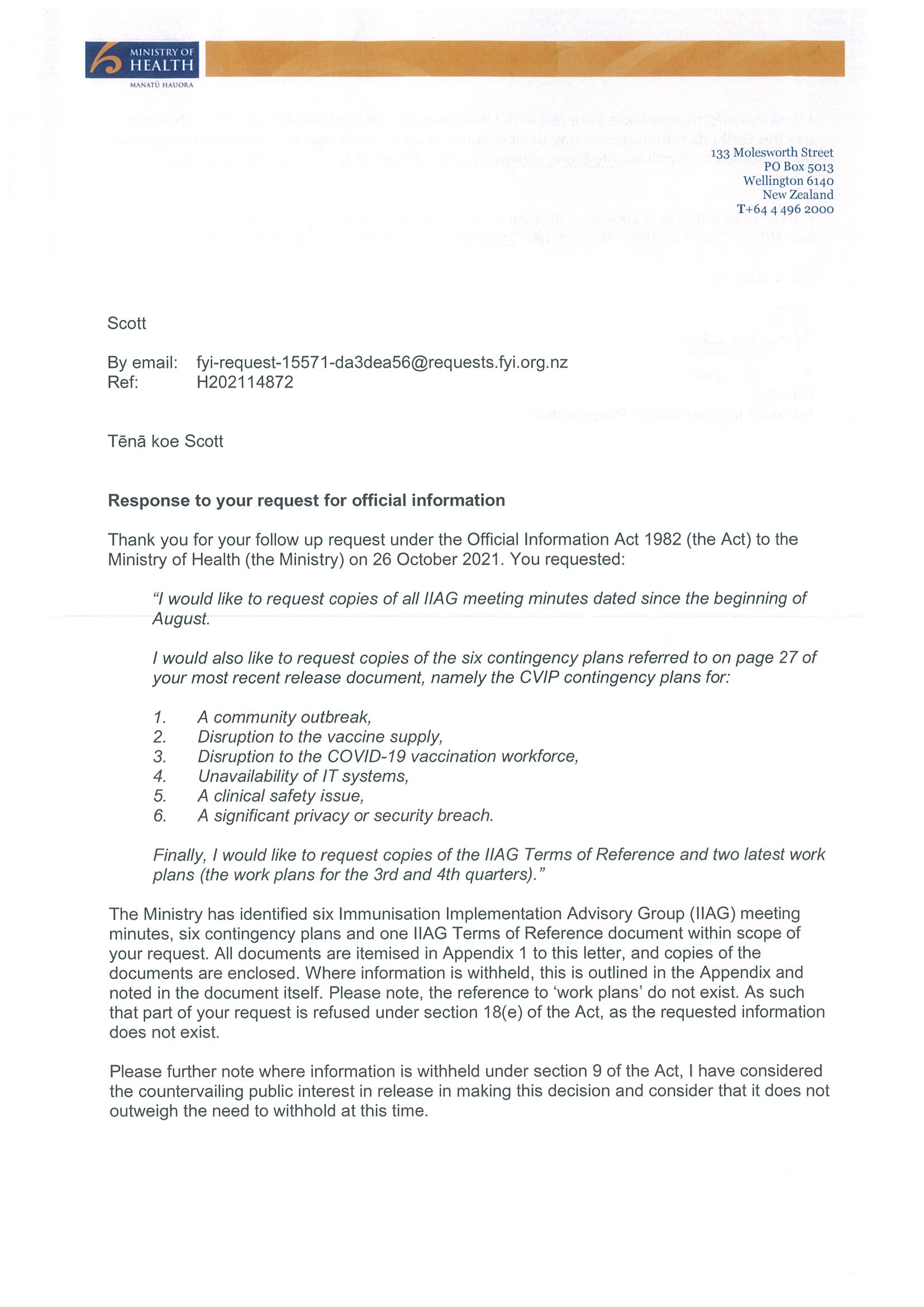
20 December 2021
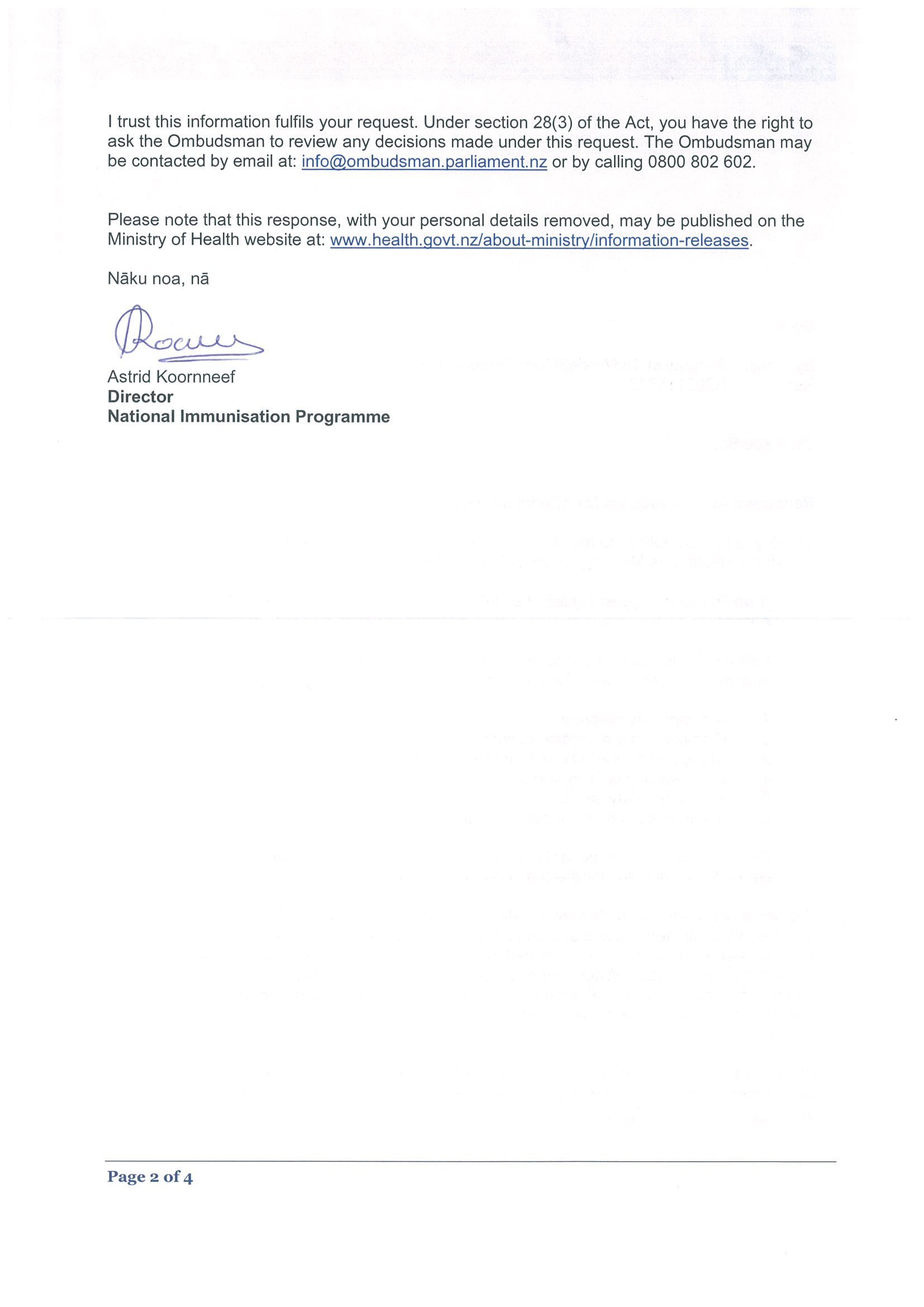
Appendix 1: List of documents for release
# Date
Document details
Decision on release
1 5 August 2021
IIAG Minutes
Released in ful .
2 19 August 2021
3 3 September 2021
4 17 September 2021
5 1 October 2021
6 15 October 2021
7 Date last reviewed:
Contingency Planning: Community
Released with some
30 November 2021
Outbreak of COVID-19
information withheld under
the fol owing sections of the
Act:
Section 9(2)(a) to
protect the privacy
of natural persons;
Section 9(2)(c) to
avoid prejudice to
measures protecting
the health or safety
of members of the
public.
8
Contingency Planning: Disruption to
the supply of vaccines, PPE or
consumables
9
Contingency Planning: Disruption to
the availability of vaccinator or
administrator workforce
10
Contingency Planning: Unavailability
of IT systems
11
Contingency Planning: Clinical Safety Released in ful .
Issue
12
Contingency Planning: Significant
Released with some
Privacy or Security Breach
information withheld under
the fol owing sections of the
Act:
Section 9(2)(a)
Section 9(2)(c)
13 5 August 2021
COVID-19 Immunisation
Released in ful .
Implementation Advisory Group:
Term of Reference
Page 3 of 3

Document 1
• The co-chair indicated that she was expecting written feedback on this issue
from members shortly. The co-chairs would probably look to meet with the
Ministry once member feedback was received.
3.
Equity Monitoring (Jason Moses)
Paper 4: Equity Presentation – 2 August 2021
• Following the recent decision of the Minister for COVID-19, the denominator
used for reporting for Group 4 is from Health Service Utilisation Population
(HSU) data rather than from NHI data. This data can be accessed at DHB
level, by dose and overlaid by e.g. age band, ethnicity etc.
• Group 4 vaccination has been under way for about three weeks. Using HSU
data means we have a more accurate representation of vaccination
performance across DHBs by age band.
• Noted that while current vaccination rates for older Māori and Pacific people
are low (as expected through the sequencing), the tables in this paper
generally show a better overall vaccination scenario for these groups than is
ACT 1982
reflected in public commentary and through DHB production planning.
• As at 1 August 2021, Māori and Pacific aged over 55 years are being
vaccinated at similar or higher rates to non-Māori non Pacific over 55 years.
• Some DHBs have delivered to their equity targets under sequencing and the
Ministry will discuss with the Minister whether these DHBs could move earlier
on the younger age bands.
IIAG perspectives and advice
INFORMATION
• Members sought clarification about the use of the HSU as a denominator for
reporting performance, when production plans are based on the Statistics NZ
denominator. This meant comparisons were difficult. The Ministry noted that it
would work with DHBs to revise their plans so that they were aligned.
• There are difficulties in making whānau bookings through the national booking
system. The Ministry confirmed that the booking system is currently able to
accept only single bookings and technology solutions are being sought. For
now, alternatives would need to be used such as making group bookings using
the national call centre.
• Members noted they may consider using some meeting time to identify these
types of operational issues and methods to address them so that they did not
become roadblocks.
4.
Commissioning and Funding
Verbal update and advice from IIAG – Co-Chairs
• Providers want to do the best for their communities, but face many ‘on the
ground’ obstacles. The primary care sector is a critical part of scale-up. Where
primary care providers do not come on board, this increases the demands on
DHBs and other providers with flow-on effects for roll-out.
• Effective national implementation requires a cen
RELEASED UNDER THE OFFICIAL tral overview of the
commissioning approach across New Zealand. The IIAG saw this as an
assurance role for the Ministry.
• The IIAG noted that while this matter is raised frequently with DHB SROs, the
Group perceives there is a discord between ‘intent’ and ‘execution’. Specific
concerns relate to:
o
achieving a level of national consistency (particularly important with a
wider range of primary care providers coming on board);
2
Document 1
o funding adequacy, funding flows and the desire for a greater level of
consistency of approach (payment timeframes, ‘fee for service’ vs ‘special
needs’ funding, the possibility of a rural adjustor);
o service provision logistics (understanding the requirements of vaccination
providers, impact of trade-offs such as allocating secure storage, and
technology challenges that constrain achievement of objectives, e.g.
inability to make whānau bookings);
o understanding the quantum of commissioning, their location, their funding
status, and overall sufficiency to support scale-up.
• The IIAG advises that it is well-placed to identify both the issues and possible
actions to address them.
Discussion
• The Ministry acknowledged there had been earlier issues with funding flows
for equity performance. The initial funding round saw funds sent directly to
providers. Funding through the second round had gone to DHBs to allow
ACT 1982
them to fund the specific requirements of their communities.
• Funding for round three had been by application. This was well subscribed.
• The recent adjustments to price per dose had necessitated some changes to
current funding arrangements.
5.
Decision to use Pfizer (12-15 year olds) and Janssen (Allison Bennett)
Paper 4: Decision to use considerations for Pfizer (12 to 15s) and Janssen
• The Ministry has received technical advice from CV-TAG following the
Medsafe ‘decision to use’ Pfizer for 12-15 year olds. Current thinking is the
INFORMATION
extension in the first instance could apply to ‘at risk’ members of this age
group.
• It was noted that New Zealand was unlikely to secure a supply of Janssen this
calendar year and that the pragmatic decision at this point was to continue
with one vaccine in the portfolio, noting the reliability of supply from Pfizer.
• The Ministry noted that it must provide its advice on these matters in the
immediate future.
IIAG perspectives and advice
• Members indicated this was a matter that required robust consideration.
Extending vaccination to those aged 12-15 years provided another variation
for roll-out which had a number of potential implications:
o communications and engagement challenges because of multiple
messaging relating to groups prioritised for vaccination;
o equity implications (not covered by Paper 4);
o the interface of this age cohort with other immunisation programmes;
o the concerns around myocarditis in younger males.
o consent processes – can children elect to be vaccinated without parental
RELEASED UNDER THE OFFICIAL
approval?
o the unknown level of confidence about this group being able to be
incorporated into DHB production plans and delivery;
o timing of any such vaccination – school holidays.
• Consideration could be given to doing scenario modelling to ensure roll-out to
this group out of sequencing could be managed.
• In respect of the Janssen vaccine, members suggested that there is merit in
having a second vaccine in the portfolio, for example some people who
declined the two-dose vaccine might accept a one-dose vaccine.
3
Document 1
6.
Strategy to drive high levels of uptake through Q.3 (Mat Parr/Matt Jones)
• The critical nine-week peak period for COVID-19 vaccination will occur in
September-October 2021. We need to maximise New Zealand’s demand
during this period.
• Primary care service providers and mass vaccination events are likely to play
the greatest roles.
• Additional feedback from members is welcomed before the next meeting.
IIAG perspectives and advice
• Driving uptake:
o Ensure clinical safety remains the key priority.
o Suggested that careful consideration is given to use of incentives.
Noted that a vaccination passport is likely to provide a strong incentive.
o Note that wider environmental issues may impact on the ability of the
workforce to deliver services.
o
ACT 1982
Consider other countries’ approaches.
7.
Transition to Future State (Mat Parr/Matt Jones)
Paper 6: CVIP Programme – Transition to Future State (Legacy) – 4 August 2021
• A team has been created to focus on the Transition to Future State.
• The paper sets out a high level approach to designing for the endemic delivery
of COVID-19 vaccinations into the future.
• Due to time constraints at the meeting, members wishing to provide feedback
can send this to Matt Jones before the next meeting.
INFORMATION
8.
Extension of Dosing Schedule (Astrid Koornneef)
Verbal update
• There is an emerging view (United Kingdom) that increasing the period of time
(i.e. to six weeks) between the first and second dose will enhance
immunogenicity from COVID-19.
• The Ministry is considering what this means for implementation in Aotearoa
New Zealand:
o need to consider the likely impacts on equity. However, it was noted that a
longer interval between doses (particularly a bulk move) would mean that
first dose vaccination would move more quickly into the younger age
groups, where Māori are a bigger proportion of the population than are non-
Maori.
o a bulk move of current second dose bookings would create spare slots that
would need to be filled. This could be beneficial in allowing for a significant
increase in the number of first doses delivered, or to provide added
flexibility for walk-ins.
• The minimum period of time between doses would remain unchanged at 21
days.
RELEASED UNDER THE OFFICIAL
• Need to consider how to manage rebooking those already in the system.
• Need to consider the impact on those who have already had their second dose.
• An announcement is likely early in the following week.
4
Document 1
Cont. IIAG perspectives and advice
• Reinforced the importance of clear communications to support this change,
including the benefits.
• Messaging to those who have already been vaccinated with a three-week
interval between doses needs very careful thinking to reassure and maintain
confidence.
• Consider if a longer timeframe between doses will impact on awareness/
willingness to be vaccinated for the second dose.
• Consider the wider impacts on providers at a local level, who are often called
directly by their clients.
• Will people have choice?
8.
General Business
• Members wishing to provide feedback on Paper 10: Interim process on booking
approach for people with disabilities, should provide this to Astrid Koornneef.
ACT 1982
• The following papers were noted:
o
Paper 8: COVID-19 National Clinical Quality and Safety Forum – Terms of
Reference – version 2
o
Paper 9: CVIP Outcome Measures – Status update – data as at 26 July
2021
o
Paper 10: IIAG work programme to September 2021.
8.
Closing/Karakia whakamutunga – Taima Campbell
INFORMATION
9.
Next meeting
Thursday 27 August 2021
1.00 p.m. – 1.30 p.m. (IIAG member session)
1.30 p.m. – 3.00 p.m. (Full attendance)
RELEASED UNDER THE OFFICIAL
5
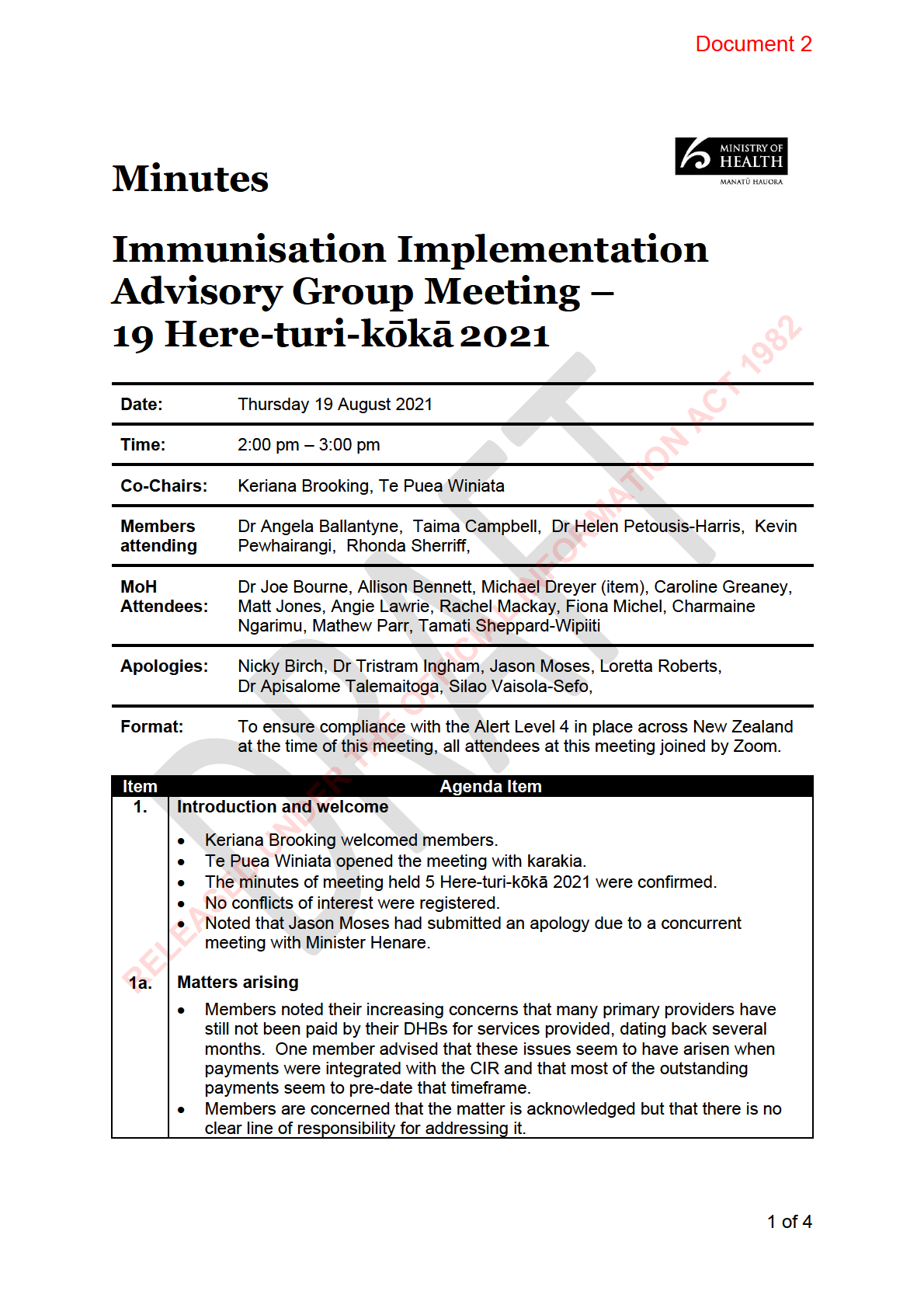

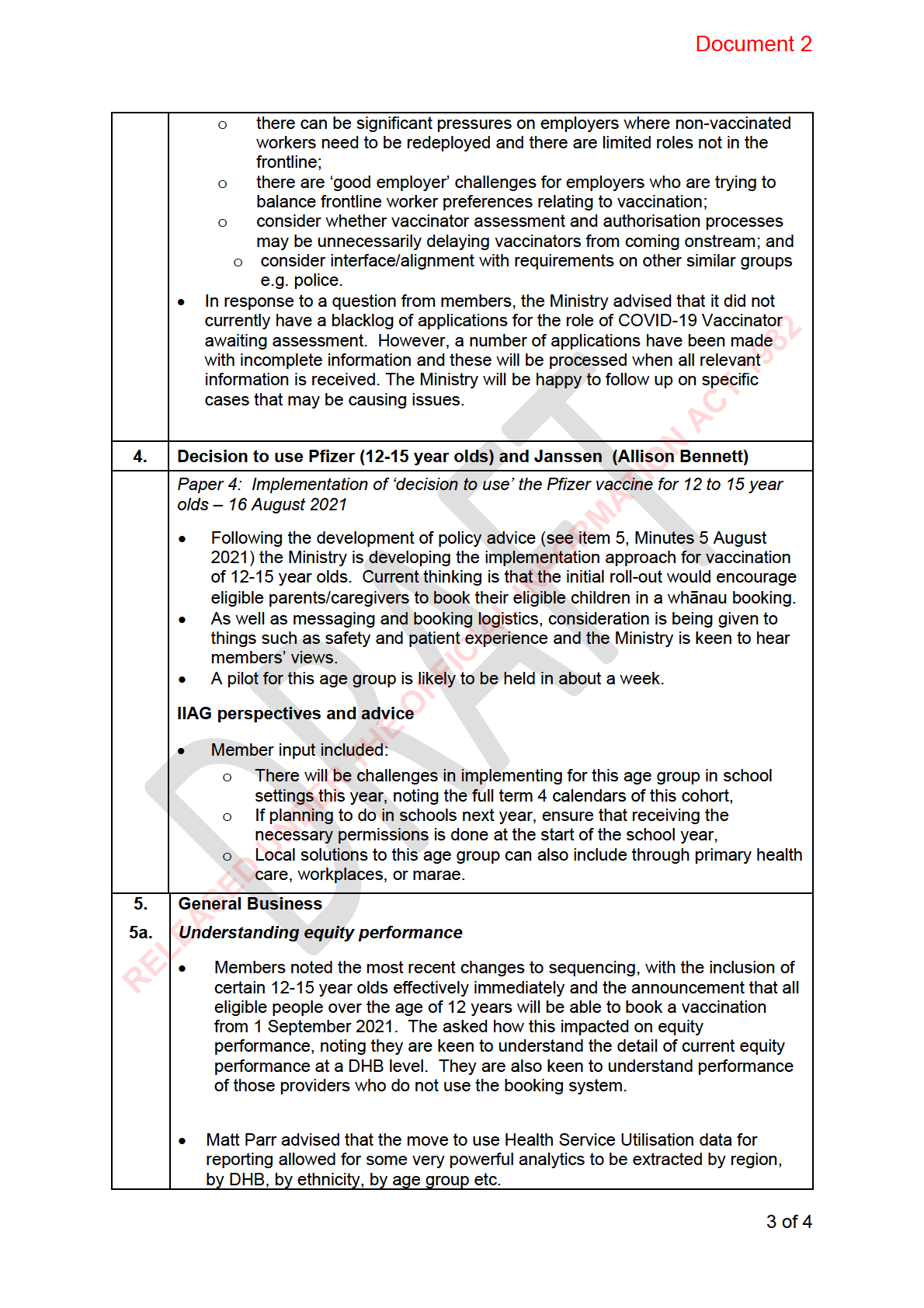
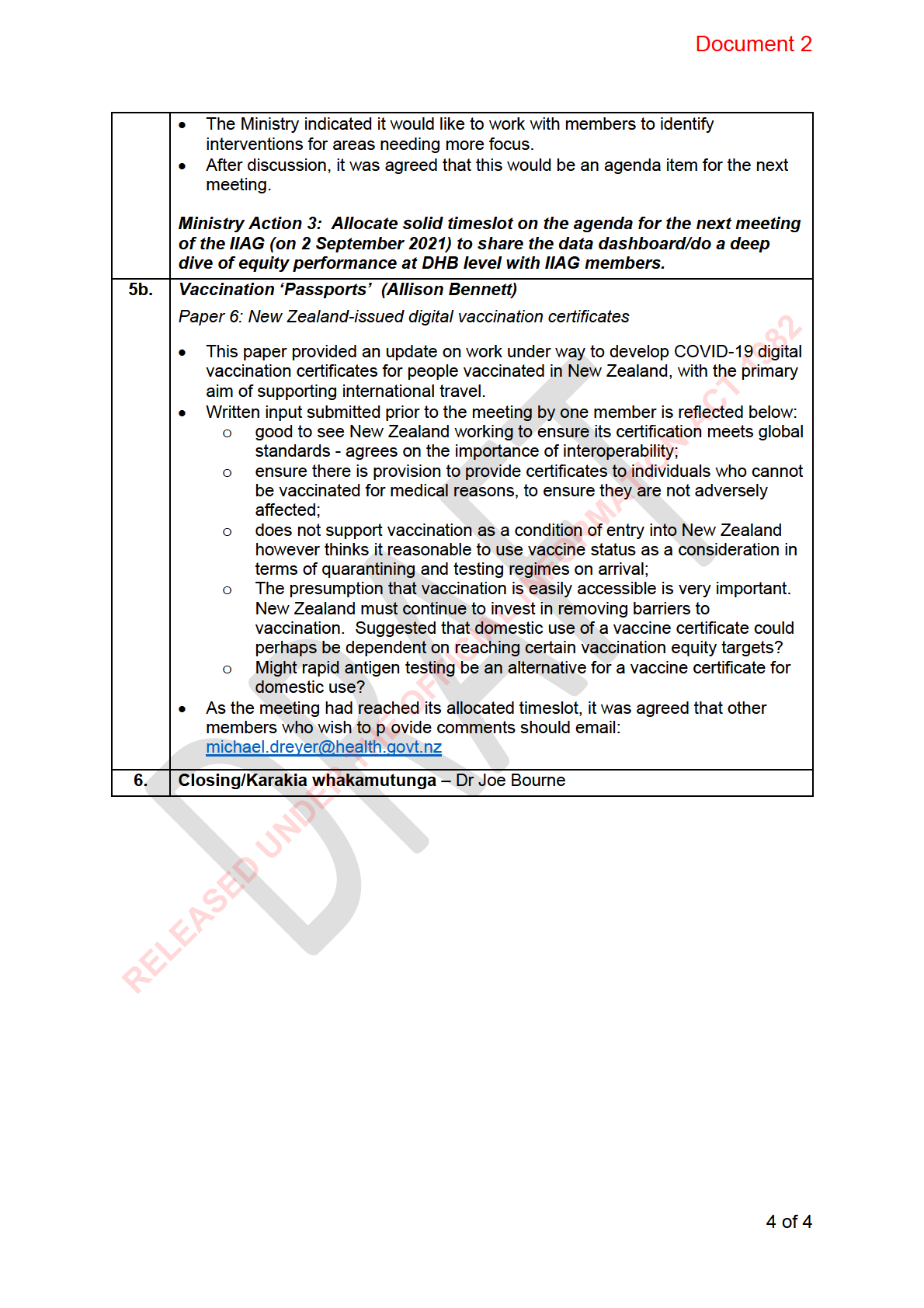

Document 3
• Every Maori provider primarily government funde3d, able to analyse how many doses,
where to open and which days are best. We’re gathering data regarding regions with a
view to further resourcing and support.
• Pacific providers are able to identify issues that are site specific. We’re working to
capture the provider and which site.
• We have invited stakeholders and Maori stakeholders to hui to discuss issues and to
look at decisions being made. Flexibility is important and when we respond it is timely
and relevant to those communities.
• Tracking areas where there are high Maori and Pacific people are enrolled.
• When we go into communities, we have targeted communications for each.
• Different agencies are focussing on Maori, Pacific and disability people so we’re
working through supporting these through further funding opportunities.
• It is noted that when we are using the data through the booking system for Maori,
bookings don’t mean they’re getting vaccinated. Also, GPs and Maori health p oviders
are doing walk-ins and booking system as well.
• On the diagram provided we note that some areas of Pacific people are a sea of green
through all age groups, and the Red and Orange areas are consistent th oughout the
ACT 1982
country.
• The Members noted it is great to see the level of data presented as there are some
good practices captured. ‘ve now opened all age groups and there are good strategies
for working out how we spread the sea of green. This data may be used by PHOs in
conversations around rationalisation.
• The big difference the data has made in enriching korero to have an informed opinion.
• It is noted there is a differential uptake across age bands and sequencing framework. A
church based approach for Pacific people and eligible whanau enabled an early
uptake. There was a high uptake also in areas where seasonal workers were deemed
essential workers.
INFORMATION
• Intelligence is gaining momentum through mainstream media and feedback.
Immunisation results from campaigns run in schools produce the highest uptake.
Canterbury is willing to take the lead on a school based programme.
• Up the coast limited number of vaccinators so provider is helping. Drive throughs are
operating. Pharmacies and GPs waiting on contracting requirements from DHB.
Vaccinators assigned to CIR is ongoing.
• Business address being used for communications with the Ministry. Current process
will need to be updated to reflect this otherwise individual contractors will go elsewhere.
Exception process will be ramped up as a result as we need to be more flexible
• There is an assurance a disability dashboard is coming.
• It is noted that the DHBs have access to denominator but may not know those to target.
The denominator is 40,000 in the ACC and DSS databases. No systematic data
collection for disability throughout the programme. These are not known by their NHI
number. Work undertaken by Disability Ministry to work through data policy issues. This
is a legacy the programme will work through.
• There is work regarding PHOs GPs completing requirements for MSD so they can
approach people directly in a soft contact to get vaccinated.
• Tamai recognised the great mihi done by Declan, Jason and Tamiti.
RELEASED UNDER THE OFFICIAL
IIAG Decisions
a) Noted: Raise with Ministry that when we get into rationalisation, we will
review population and equity distribution of supply. (Tamiti)
b) Noted: Canterbury is willing to take the lead on a school based programme. c) Noted: Personal email exemption process will be ramped up so as to include
individual contractor email addresses.
d) Noted: Legacy of database information for disability people.
3.
Booster Dose Update (Allison Bennett)
2
Document 3
Update on whether third vaccination doses will be required / offered in 2022
• We are grounding decisions for booster programme in evidence provided by science
and technical insight.
• Regulatory agencies are in discussion whether boosters are need.
• Focussing on security of supply. Oct/Nov/Dec committing to delivery if boosters
appropriate.
• CBT science evidence pending.
• Update to Ministers Sept/Oct if concrete enough system to produce programme.
Discussion about implementation of booster programme is conceptual at the moment in
this phase of the vaccination programme.
• There is increasing evidence that while people may need boosters, we will need to
include people with specific conditions that might impact their effectiveness of the
vaccine. How are we going to identify and proactively locate these people?
• At the moment the disability system doesn’t know who is disabled and who has a long
term condition. Alignment with other vaccination programmes may inform the
programme in 2022. Population requiring annualisation of all vaccinati ns will need
ACT 1982
strategizing to resolve COVID booster process.
• Further discussion offline with the Chair advised.
4.
Vaccine Passports (Michel Dreyer)
Update on vaccine passports / vaccine certificates
• People will need testing and passports going forward Travel certificates when coming
and going from NZ and considering emerging global expectations.
• Fraud and Identity issues to be considered. NZ using European version which is most
common and globally accepted.
INFORMATION
• Passports will need to be digital and other. There is a basic version available for
phones in beta testing.
• Private and personal information, secure identity through RealMe, health identity to be
easily setup online or with GP support.
• Opportunity with the identity data users can self-ethnicity, self-determine disability and
self-Iwi affiliation.
IIAG Decisions
a) Noted: IIAG would like to discuss further as lots of ideas to consider. Including
living with COVID and how we manager this with passports. Tabled a topic for next
meeting
5.
Non-Regulated Workforce – Training and Procedures (Fiona Michel)
• 12817 Trained COVID vaccinators, 1149 Maori and 411 Pacific people. 50% of trained
workforce have vaccinated in the programme so far. Workforce working under
supervision is 267 completed training. Largest is 121 Maori, 26 Pacific. 18 people are
actively vaccinating from this cohort. 18 people have delivered over 1500 vaccinations.
• Disability agency providers and other NGOs are open to doing communications to
interact with their population base.
• Acknowledged this role is an opportunity to get people into the workforce. There are
RELEASED UNDER THE OFFICIAL
still regulatory barriers to make this happen.
• This role could continue after COVID within the general programme.
• It is noted workers can do online training, but workplace training is a requirement. Staff
have completed training but not authorised so working through barriers to
authorisations. There is no backlog in authorisations just in getting the requests
submitted.
Action: Will come back to IIAG with information around breaking barriers to enable
the workforce. (Loretta)
3
Document 3
Action: Will work further to address need to deliver service in other ways, such as
carpark delivery. (Loretta)
6.
Childhood Immunisations (Jared Solloway, Kellie Priest)
• Rates are declining around the country specifically Maori and Pacific children.
• DHBS submitted plans to address declining rates with equity focus and timelines of
achievement.
• IIAG to review plans and summary of decisions, and submit comments in its role of
providing best practice, accessibility and equity advice.
Action: Disability Advisory Group minutes to IIAG as a standard agenda item.
(Tristram)
Action: Provide summary of decisions in the plans. (Jared)
Action: Taima agreed to review plans on behalf of IIAG. (Taima)
7.
Closing/Karakia whakamutunga
ACT 1982
8.
Next meeting
Friday 17th September 2021
11.00 a.m. – 11.30 a.m. (IIAG member session)
11.30 p.m. – 1.00 p.m. (Full attendance)
INFORMATION
RELEASED UNDER THE OFFICIAL
4
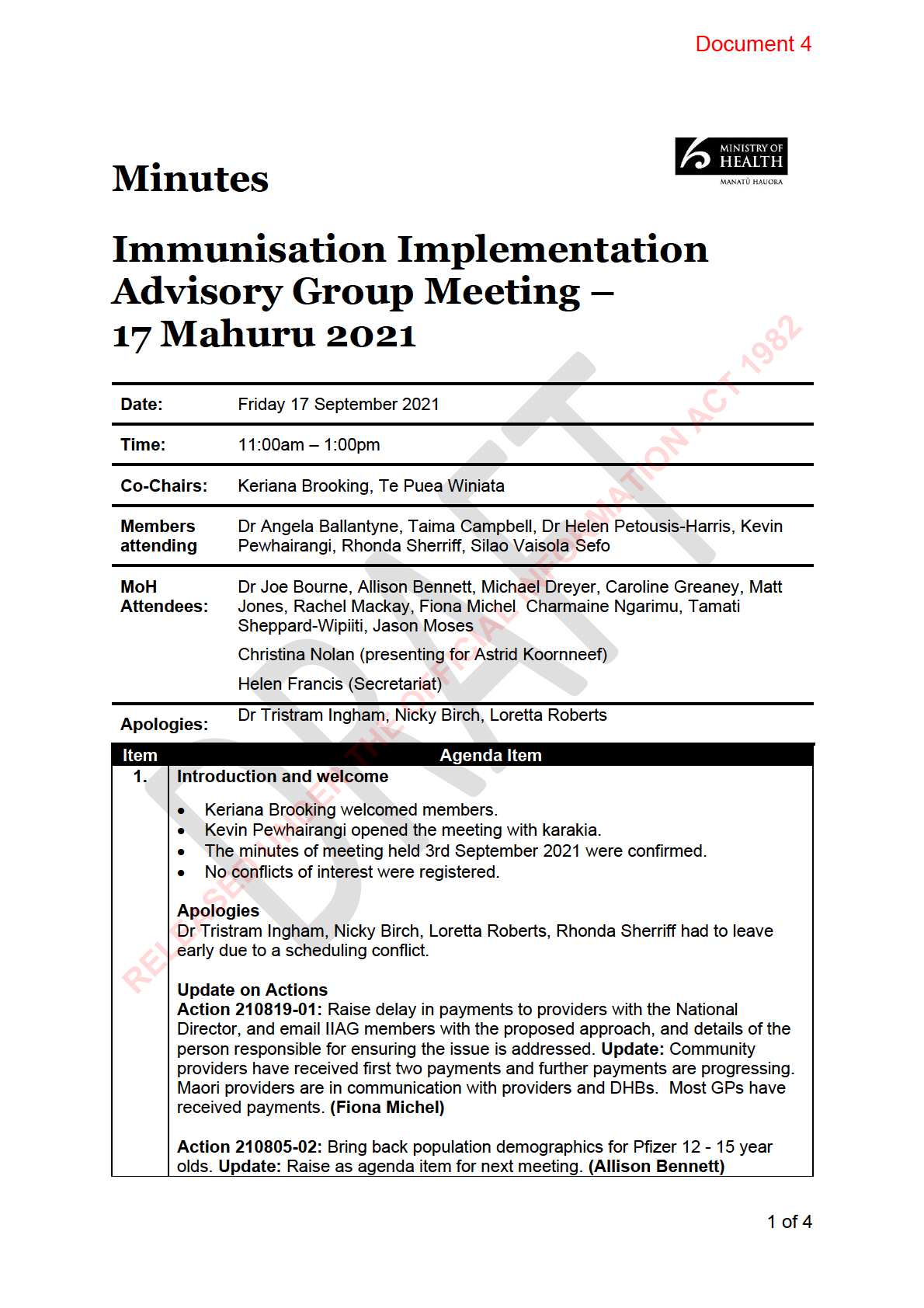
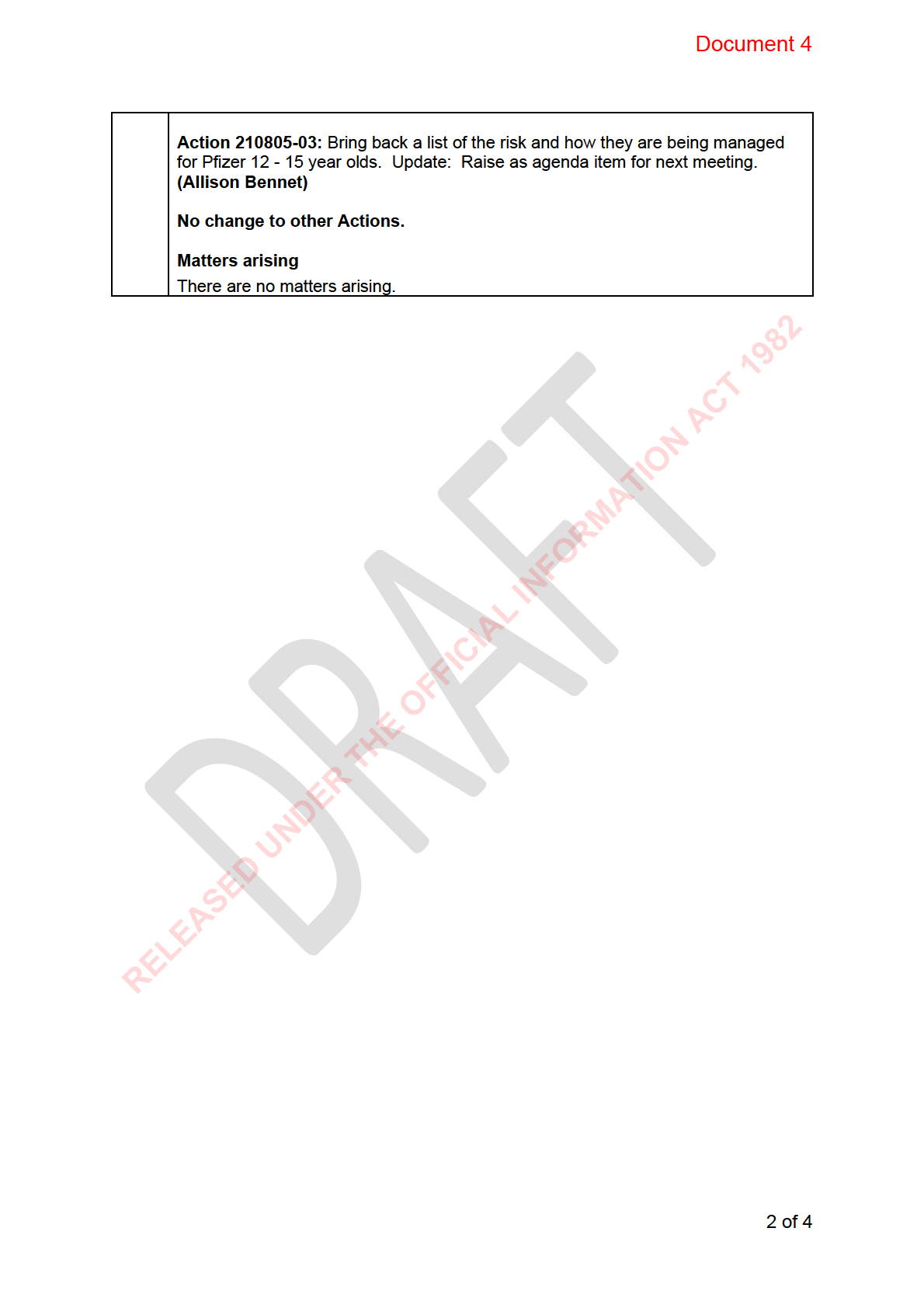
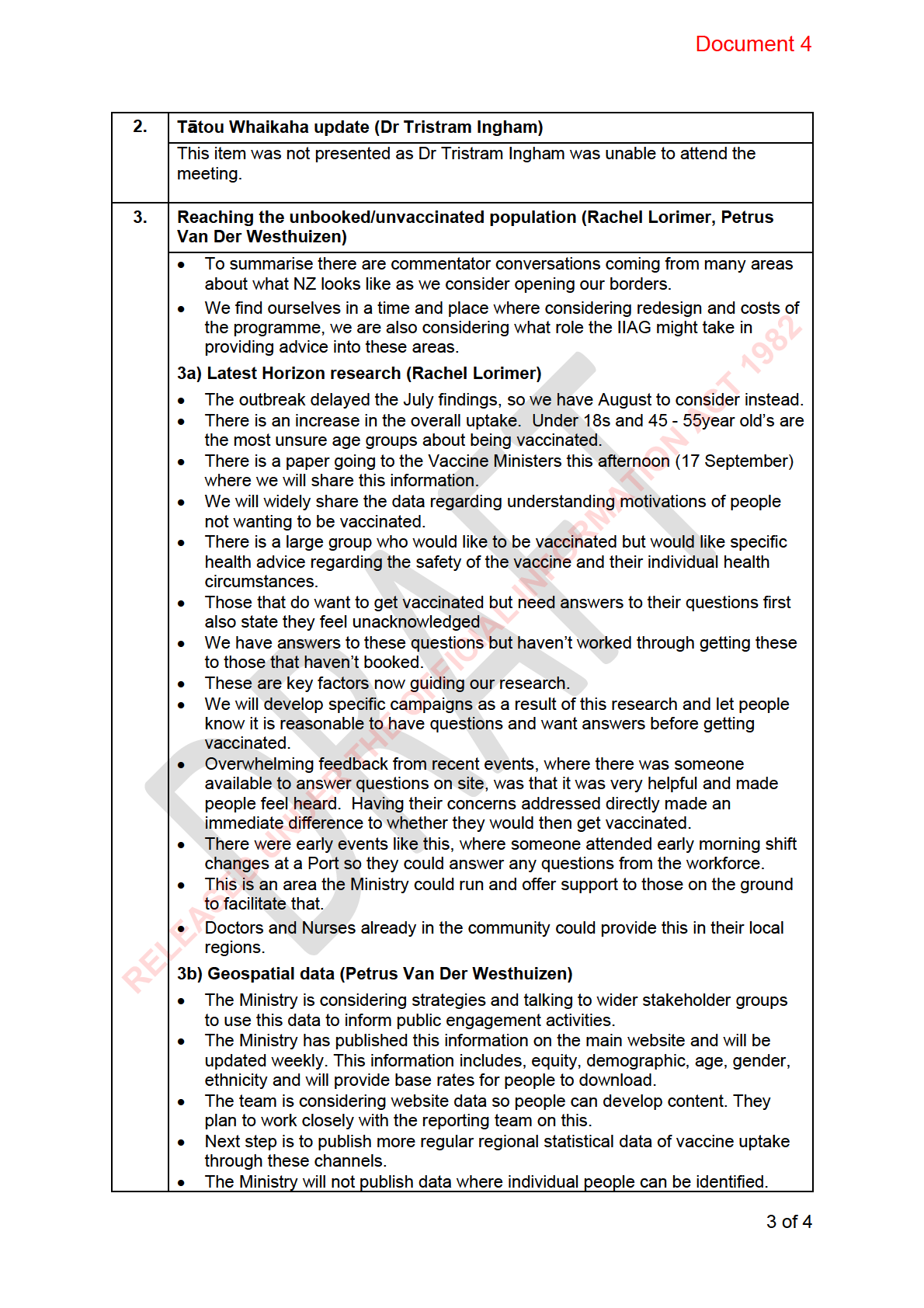
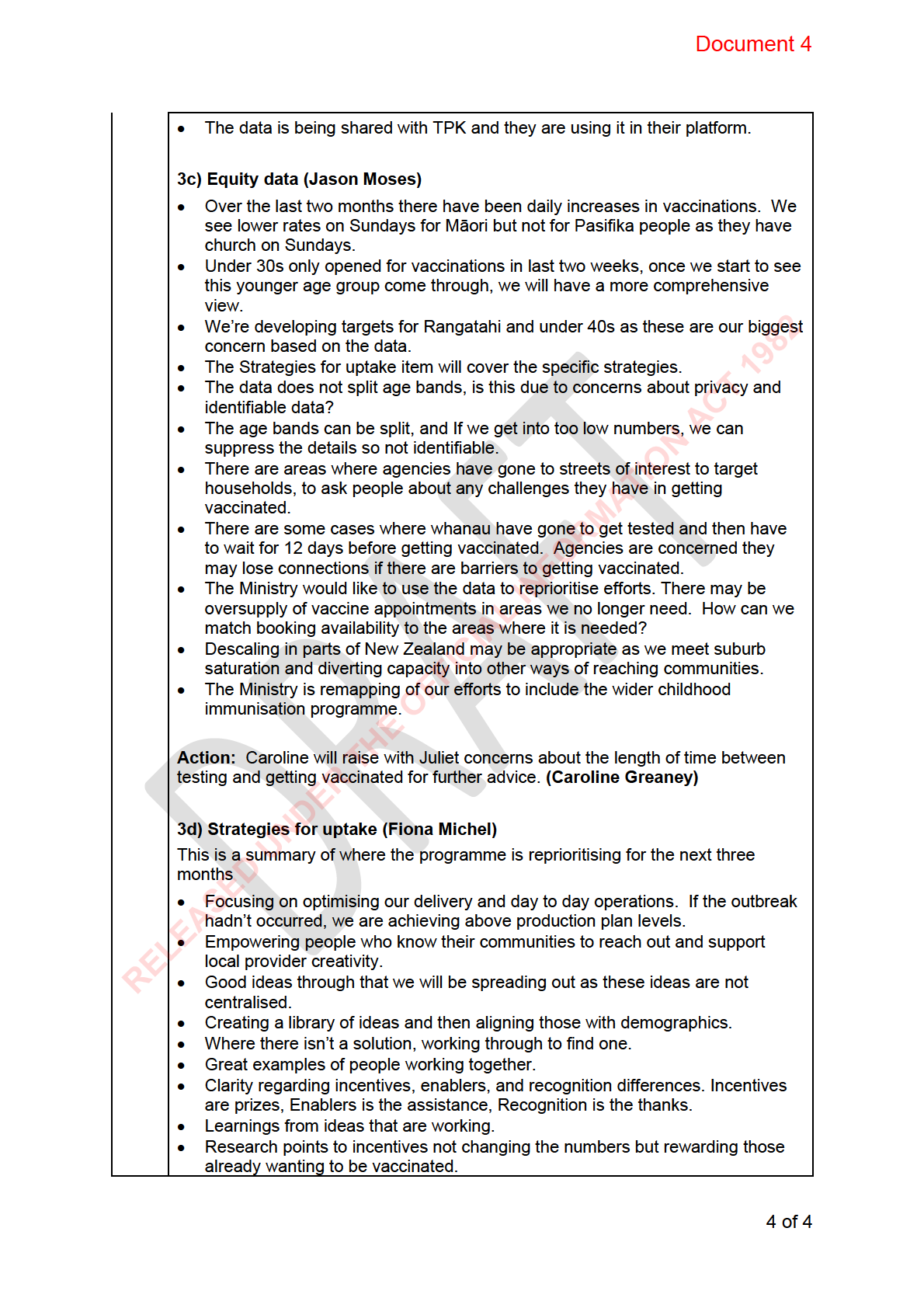

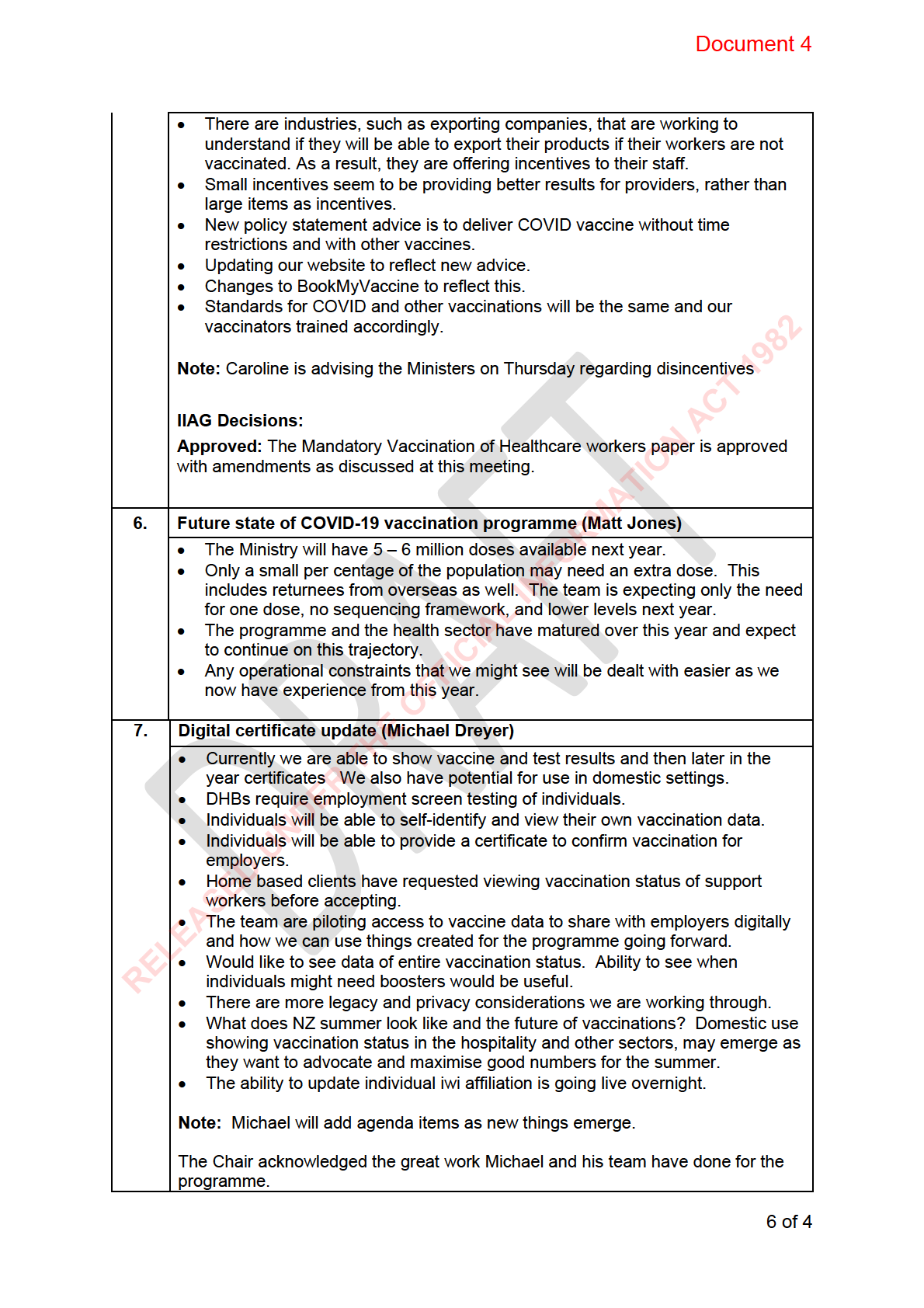
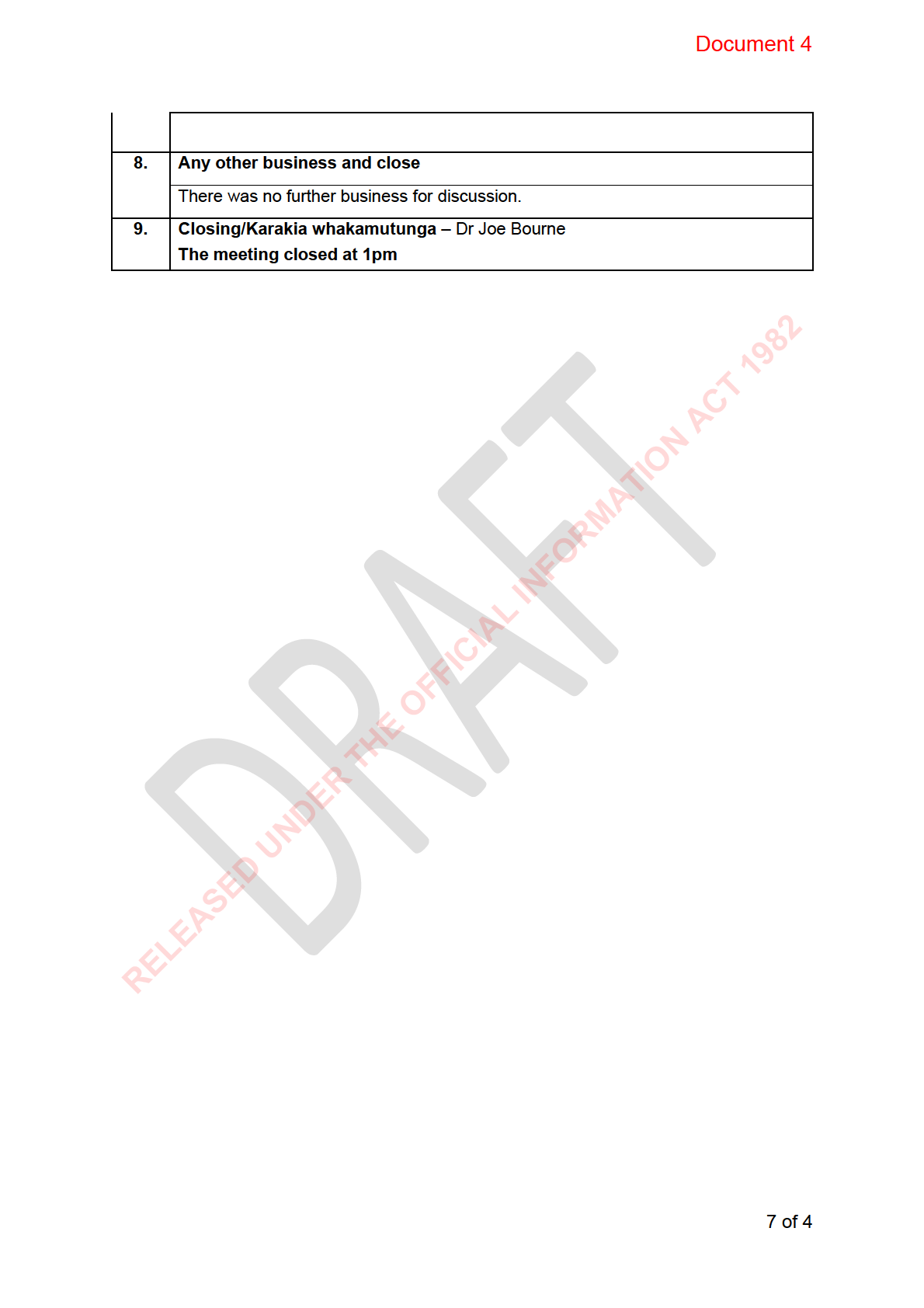
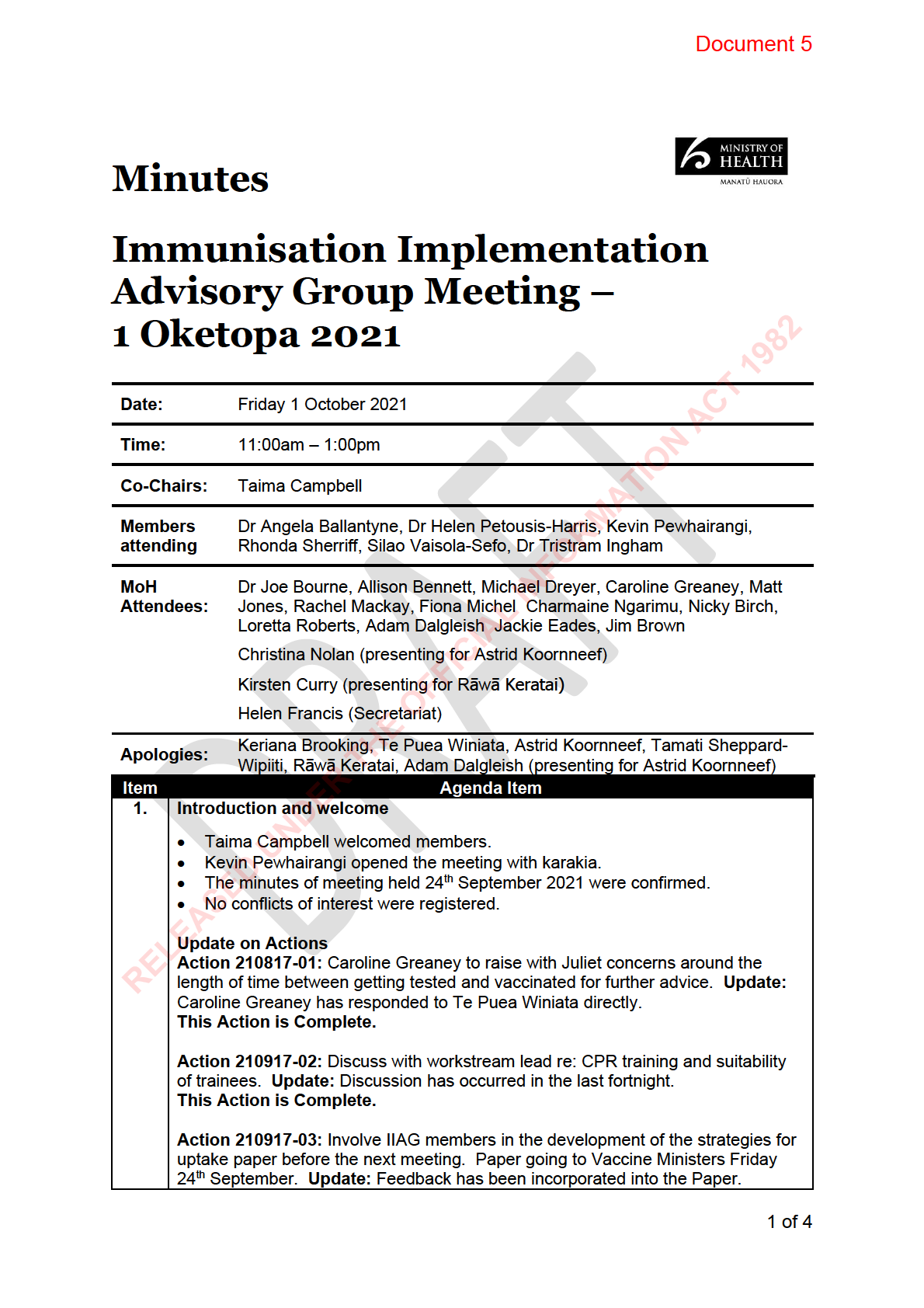
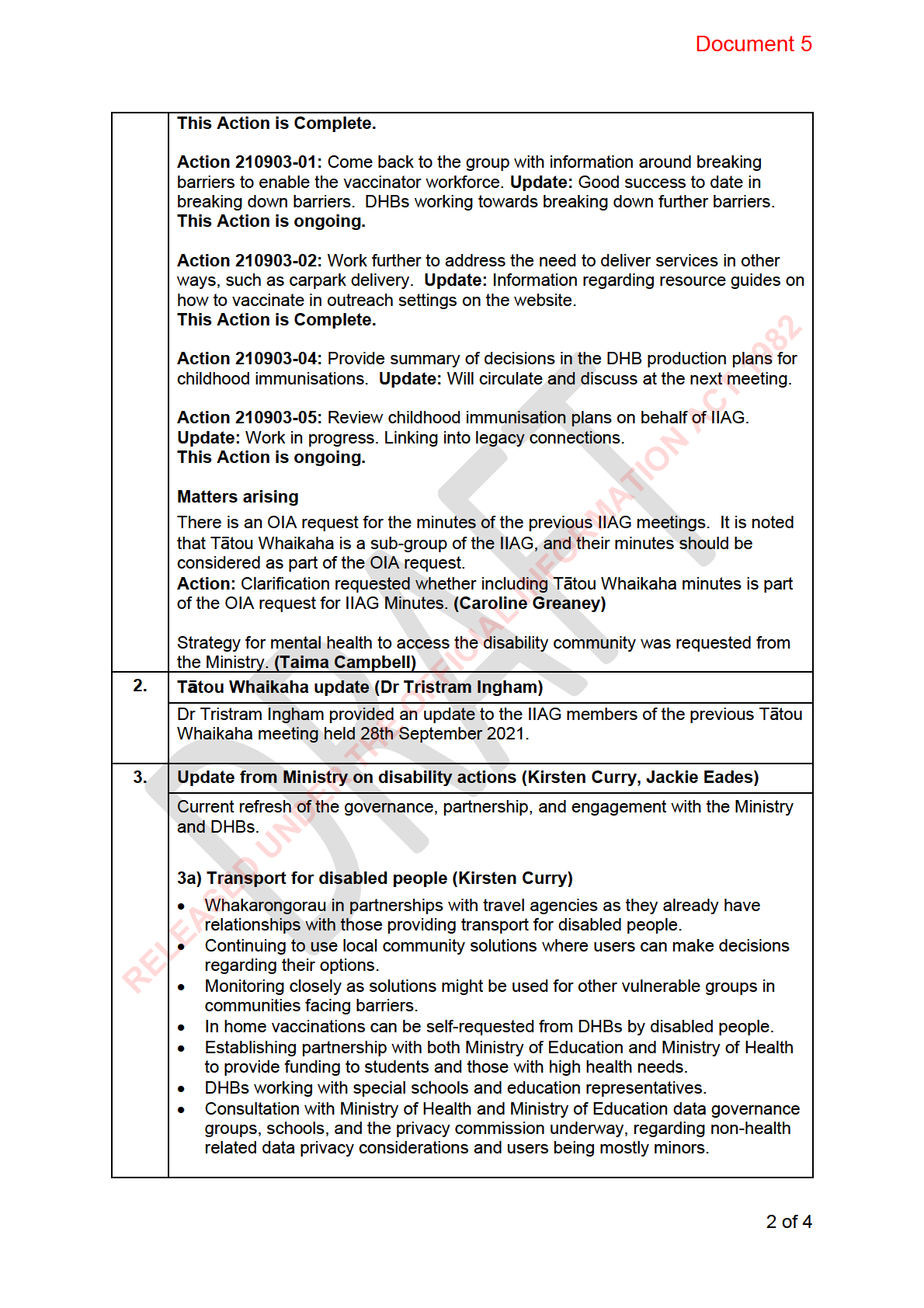
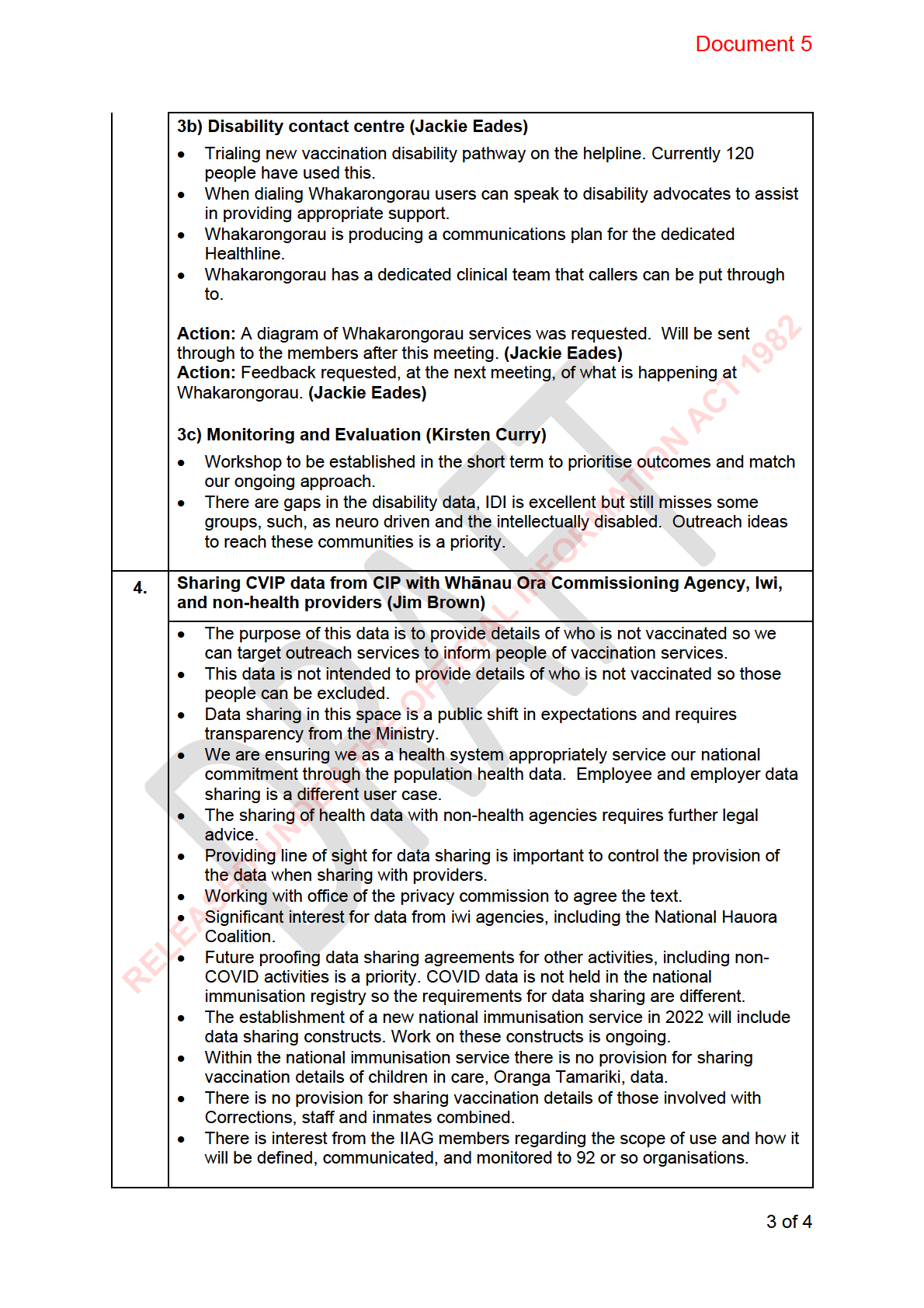

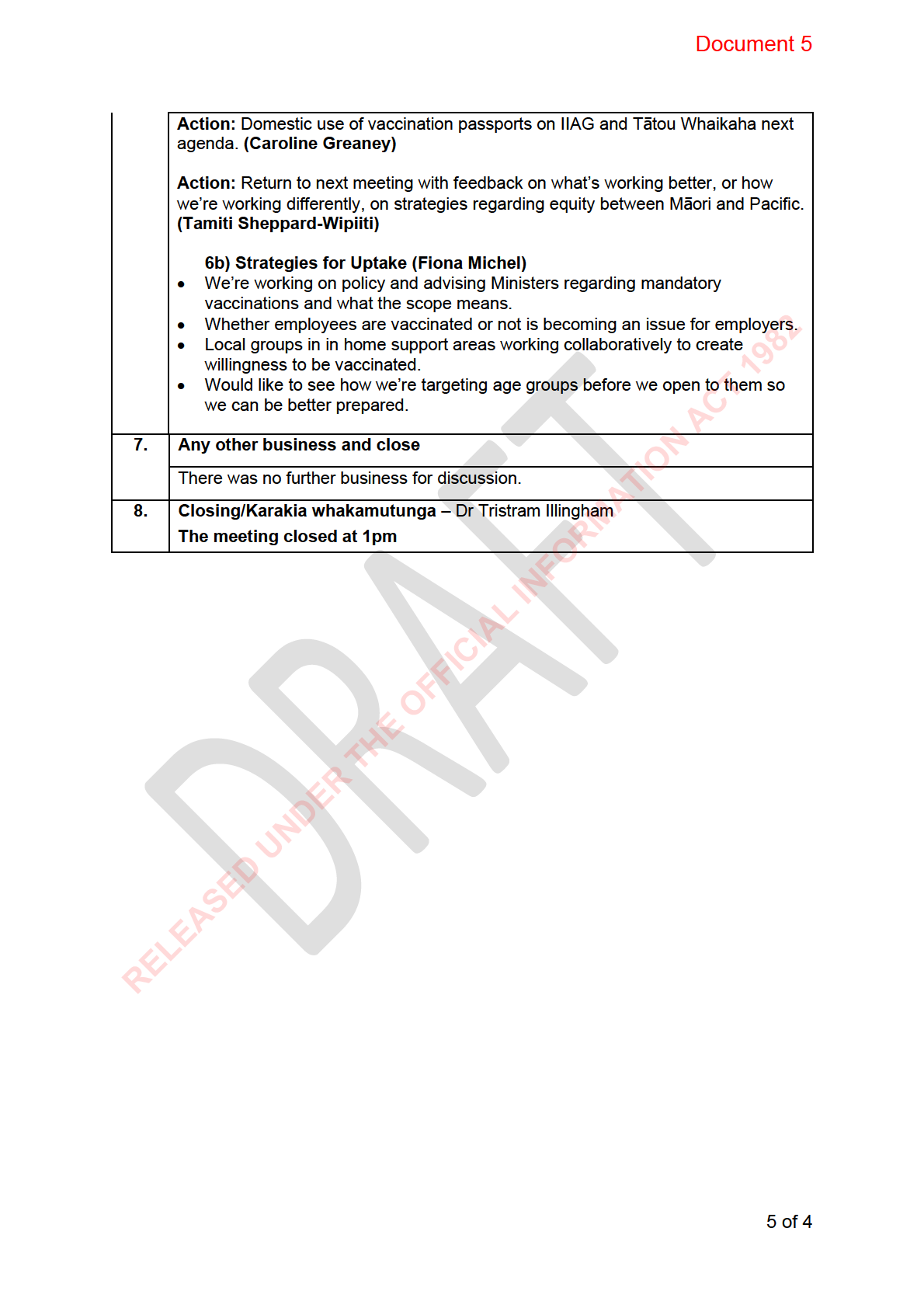
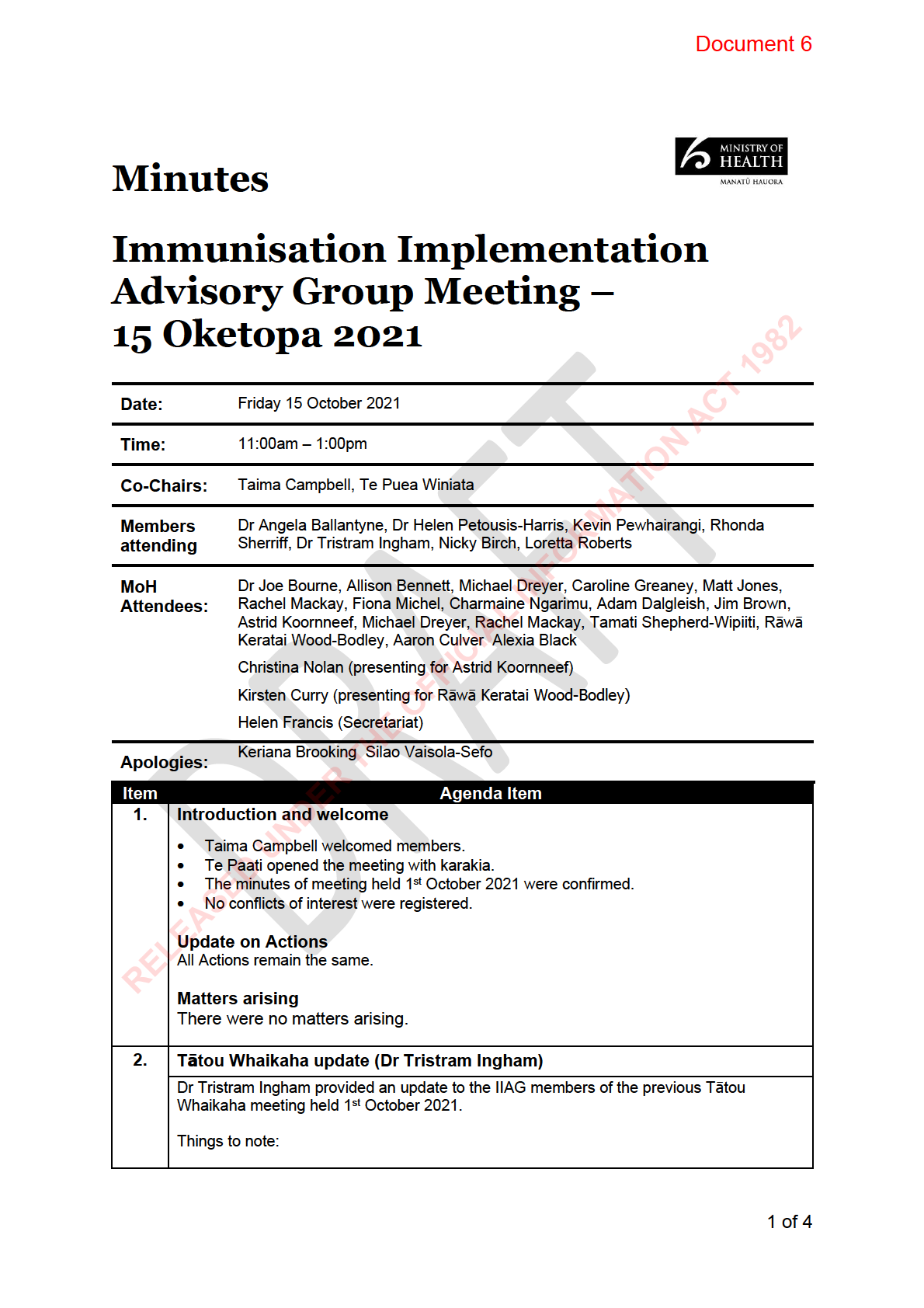
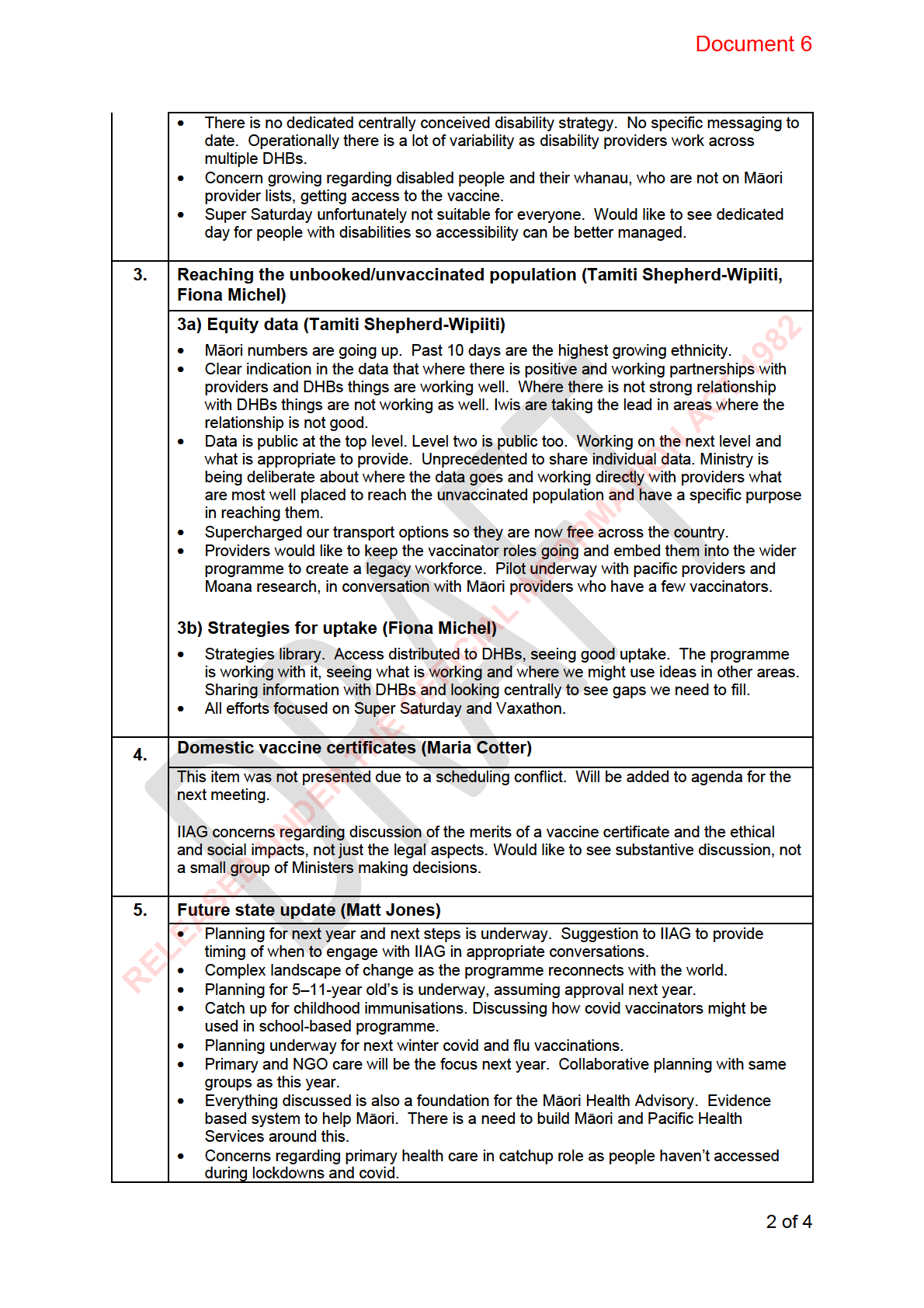
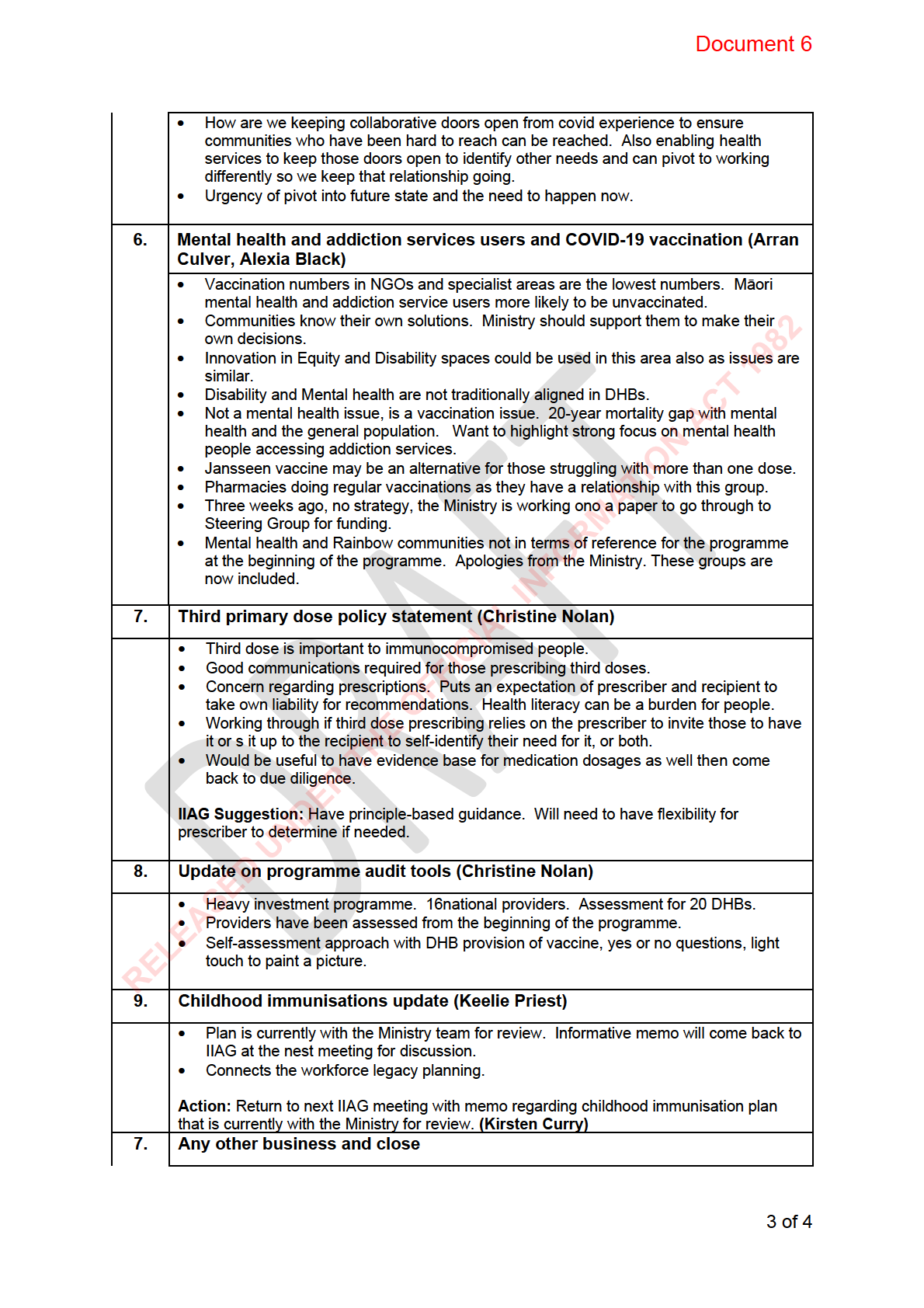
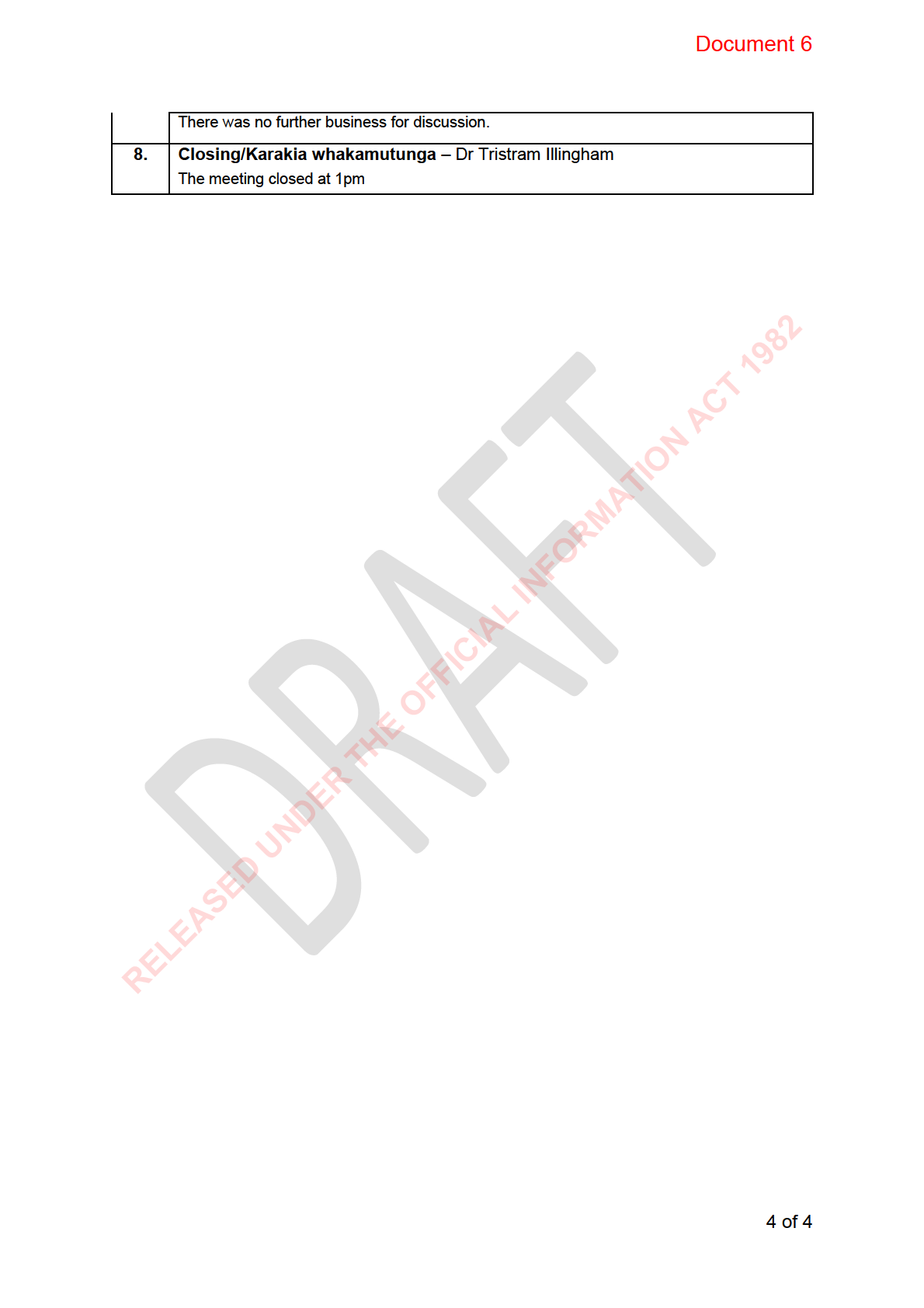
Document Outline























